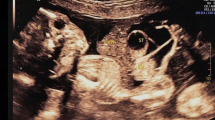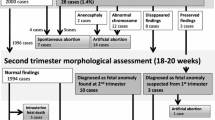Abstract
Objective
To evaluate the results and the necessity of chromosome analysis in fetuses prenatally detected with a neural tube defect and to determine the significance of ultrasonographic evaluation for the identification of underlying or accompanying chromosomal anomalies.
Methods
Ninety fetuses that underwent prenatal and/or postnatal chromosome analysis after being diagnosed with open neural tube defects (NTD) between the years 2006 and 2010 in the Department of Obstetrics and Gynecology at Ondokuz Mayis University School of Medicine were included in this study. Detailed fetal ultrasonography was performed in all cases in order to investigate any additional anomalies. Karyotype was determined in the prenatal period by amniocentesis in 72 (80 %) of the 90 fetuses, and by cordocentesis in 5 (5.5 %). In 13 (13.3 %) fetuses, karyotype was determined in the postnatal period by blood sampling.
Results
Fourteen (15.5 %) of the 90 fetuses were diagnosed with acrania/anencephaly, 14 (15.5 %) with encephalocele, 2 (2.2 %) with iniencephaly, 60 (66.6 %) with open spina bifida. None of the 90 fetuses with open NTD who had undergone chromosome analysis was diagnosed with chromosomal anomalies. None of the 19 (21.1 %) fetuses diagnosed with additional ultrasound findings had a chromosomal abnormality, either. Seventy-one (78.9 %) fetuses having sonograhically isolated NTD were also isolated in postmortem examination.
Conclusion
In fetuses with open NTD, we could not find the chromosomal anomaly rate as high as reported in previous literature. The necessity of fetal karyotyping should be questioned especially in isolated cases.
Similar content being viewed by others
References
Tunçbilek E (2004) Türkiye’deki yüksek nöral tüp defekti sıklığı ve önlemek için yapılabilecekler. Çocuk Sağlığı ve Hastalıkları Dergisi 47:79–84
Sepulveda W, Corral E, Ayala C (2004) Chromosomal abnormalities in fetuses with open neural tube defects: prenatal identification with ultrasound. Ultrasound Obstet Gynecol 23:352–356
Kennedy D, Chitayat D, Winsor EJT (1998) Prenatally diagnosed neural tube defects: ultrasound, chromosome and autopsy or postnatal findings in 212 cases. Am J Med Genet 77:317–321
Harmon JP, Hiett AK, Palmer CG (1995) Prenatal ultrasound detection of isolated neural tube defects : is cytogenetic evaluation warrented? Obstet Gynecol 86:595–599
Babcook CJ, Ball RH, Feldkamp ML (2000) Prevelance of aneuploidy and additional anatomic abnormalities in fetuses with open spina bifida : population based study in Utah. J Ultrasound Med 19:619–623
Babcook CJ, Goldstein RB, Filly RA (1995) Prenatally detected fetal myelomeningocele: is karyotype analysis warranted? Radiology 194:491–494
Hume RF, Drugan A, Reichler A (1996) Aneuploidy among prenatally detected neural tube defects. Am J Med Genet 61:171–173
O’Reilly GC, Shields LE (2000) Karyotyping for isolated neural tube defects. A report of two cases. J Reprod Med 45:950–952
Main DM, Mennuti MT (1986) Neural tube defects: issues in prenatal diagnosis and counselling. Obstet Gynecol 67:1–16
Botto LD, Moore CA, Khoury MJ, Erickson JD (1999) Neural-tube defects. N Engl J Med 341:1509–1519
Nicolaides KH, Snijders RJ, Gosden CM, Berry C, Campbell S (1992) Ultrasonographically detectable markers of fetal chromosomal abnormalities. Lancet 340:704–707
Sturgiss S, Robson S (1995) Prognosis for fetuses with antenatally detected myelomeningocele. Fetal Matern Med Rev 7:235–249
Lindfors K, McGahan J, Tennant F, Hanson F, Walter J (1987) Midtrimester screening for open neural tube defects: correlation of sonography with amniocentesis results. AJR 149:141–145
Crandall BF, Corson VL, Goldberg JD, Knight G, Salafsky IS (1995) Folic acid and pregnancy. Am J Med Genet 55:134–135
Rittler M, López-Camelo J, Castilla EE (2004) Sex ratio and associated risk factors for 50 congenital anomaly types: clues for causal heterogeneity. Birth Defects Res A Clin Mol Teratol 70:13–19
Xiao KZ, Zhang ZY, Su YM, Liu FQ, Yan ZZ, Jiang ZQ, Zhou SF, He WG, Wang BY, Jiang HP et al (1990) Central nervous system congenital malformations, especially neural tube defects in 29 provinces, metropolitan cities and autonomous regions of China: Chinese Birth Defects Monitoring Program. Int J Epidemiol 19:978–982
Lary JM, Paulozzi LJ (2001) Sex differences in the prevalence of human birth defects: a population-based study. Teratology 64:237–251
Li Z, Ren A, Zhang L, Ye R, Li S, Zheng J, Hong S, Wang T (2006) Extremely high prevelance of neural tube defects in a 4-county area in Shanxi Province, China. Birth Defects Res 76:237–240
Tuncbilek E, Koc I (1994) Consanguineous marriage in Turkey and its impact on fertility and mortality. Ann Hum Genet 58:321–329
Kir T, Güleç M, Bakir B, Hoşjgönül E, Tümerdem N (2005) The frequency and effecting factors of consanguineous marriage in a group of soldiers in Ankara. J Biosoc Sci 37:519–523
Akbayram S, Sari N, Akgün C, Doğan M, Tuncer O, Caksen H, Oner AF (2009) The frequency of consanguineous marriage in eastern Turkey. Genet Couns 20:207–214
Conflict of interest
We declare that we have no conflict of interest.
Author information
Authors and Affiliations
Corresponding author
Rights and permissions
About this article
Cite this article
Yazici, L.E.E., Malatyalioglu, E., Sakinci, M. et al. Chromosomal anomalies and additional sonographic findings in fetuses with open neural tube defects. Arch Gynecol Obstet 286, 1393–1398 (2012). https://doi.org/10.1007/s00404-012-2469-1
Received:
Accepted:
Published:
Issue Date:
DOI: https://doi.org/10.1007/s00404-012-2469-1




